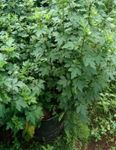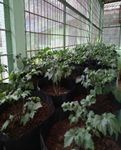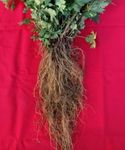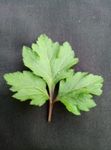Morpho-agronomic characteristics of valerian (Valeriana officinalis L.) derived from in-vitro culture
←
→
Page content transcription
If your browser does not render page correctly, please read the page content below
E3S Web of Conferences 306, 01001 (2021) https://doi.org/10.1051/e3sconf/202130601001
1st ICADAI 2021
Morpho-agronomic characteristics of valerian
(Valeriana officinalis L.) derived from in-vitro
culture
Siti Fatimah Syahid1*, Hera Nurhayati1, and Budi Hartoyo2
1Indonesian Spices and Medicinal Crops Research Institute, Bogor, Indonesia
2Central Java Assessment Institute for Agricultural Technology, Indonesia
Abstract. Valeriana officinalis belongs to the Valerianaceae family, is a
well-known herb and medicinal plant. Plant roots are commonly used as
medicine by the pharmaceutical industry. Observation on morpho-
agronomic characteristics of valerian propagated in vitro is needed to
determine their morphological characteristics and production in the field.
The study aimed to observe the morphological characteristics of valerian
derived from in vitro culture. The experiment was conducted at the
Indonesian Spices and Medicinal Crops Research Institute (ISMCRI) Bogor,
arranged in a Completely Randomized Design with three replications. Each
replication consisted of ten individual plants. Valerian plantlets from in
vitro culture were acclimatized in the greenhouse and planted in media
composed of a mixture of soil, compost, and husk. Afterward, 3 months old
valerian was then transferred into a polybag. The plants were harvested at 9
and 12 months after planting (MAP). Valerian plantlets from in vitro
propagation were successfully acclimatized in the greenhouse. Furthermore,
the morphological characteristics of the plant were similar to the parents.
The yield was significantly higher at 12 MAP than 9 MAP. The tissue culture
technique was prospective for valerian propagation to support rapid plant
material provision for seeds or raw material for the pharmaceutical industry.
1 Introduction
Valerian (Valerian. officinalis L.) is originally from Europe. Plant roots are commonly used
as medicine by the pharmaceutical industry. Valerian root is a popular and widely available
herbal supplement, primarily used to treat insomnia and anxiety [1]. Moreover, valerian is
one of the best-selling drugs in Europe for a sedative. Valerian extracts are currently
considered dietary supplements, primarily comprised of dried root or root extracts,
formulated into tablets or soft gelatine capsules [2].
V. officinalis belongs to Valerianaceae family, is a well-known herb and medicinal plant
[3]. The genus of Valerian comprises nearly 200 species, but V. officinalis L. is the only
species that is most often used as a herbal medicine [4]. The known pharmacologically active
compounds detected in valerian extracts are alkaloids, terpenes, organic acids, and its
* Corresponding author: fatimahsyahidsitti@gmail.com
© The Authors, published by EDP Sciences. This is an open access article distributed under the terms of the Creative Commons
Attribution License 4.0 (http://creativecommons.org/licenses/by/4.0/).E3S Web of Conferences 306, 01001 (2021) https://doi.org/10.1051/e3sconf/202130601001
1st ICADAI 2021
derivates, valepotriates, and flavones. Valepotriates are considered the main compounds
responsible for the sedative activity of the Valerianaceae.
Valerian can be propagated either generatively by seed or vegetatively using tillers.
However, the main problem in conventional propagation is disease attack [5]. Disease-free
valerian planting materials can be obtained through in vitro propagation. The success of in
vitro propagation is determined by various factors such as genotypes, growth media, the
balance of plant growth regulator (PGR) used in the media, and the culture growth condition.
The culture medium with an optimal supply and a suitable combination of PGR will increase
the success of in vitro plant regeneration [6].
Micropropagation of valerian in vitro has been conducted at Indonesian Spices and
Medicinal Crops Research Institutes (ISMCRI) using rhizome as an explants [7]. However,
the morphological characteristics of the plants grown in the greenhouses have not been
observed yet. Thus, the study aimed to observe the morphological characteristics of valerian
derived from in vitro culture.
2 Materials and methods
The research was conducted at the greenhouse of ISMCRI Bogor (240 m asl), West Java,
Indonesia. The planting material used was valerian plantlets derived from in vitro culture.
Valerian plantlets were removed from culture bottles and washed to remove the agar (Figure
1a). The plantlets were then transferred into a small plastic cup containing sterile media (soil,
compost, and husk), covered by a polyethylene bag to maintain the humidity (Figure 1b and
c). The polyethylene bag was opened gradually at two weeks after transplantation, and in one
month, it was removed entirely. The plants were maintained in the greenhouse for three
months. The 3 month-old valerian was then planted in a 40 cm x 50 cm polybag filled with
soil and manure (2 : 1) as growing media. The plants were maintained in the greenhouse until
5 months old and then relocated to the outside greenhouse. The plants were harvested at 9
and 12 months after planting (MAP).
a b c d
Fig. 1. Valerian acclimatization: a) valerian plantlets, b) acclimatized plants, c) one-month-old-
acclimatized valerian, d) valerian at two months after planting.
The morphological characteristics observed were qualitative and quantitative characters
of the stem (color, shape, size), leaf (color, shape, size), and root (color, shape, weight). All
the quantitative characteristics were measured at 5, 9, and 12 MAP. Other parameters
observed were plant growth (tillers number, plant height, length, width, and thickness of the
leaf) and yield (fresh and dry weight of roots and root length). The plants were harvested
twice at 9 and 12 MAP. Root fresh weight was measured after cleaning the roots from debris
and soil, whereas root dry weight was quantified after drying up the roots for two days.
Qualitative characteristics such as the color of leaf, stem, leaf bone, and flower were
identified using RHS (The Royal Horticultural Society) color chart. In addition, the plant
morphological characteristics were determined following [8]. The parent plants were also
2
2E3S Web of Conferences 306, 01001 (2021) https://doi.org/10.1051/e3sconf/202130601001
1st ICADAI 2021
observed their morphology characteristics visually as a control to evaluate the similarity with
valerian plantlets derived from in vitro culture.
The experiment was arranged in Completely Randomized Design, two harvesting times,
9 and 12 MAP as the treatments, with three replications. Each replication consisted of 10
individual plants. The data were analyzed using Statistical Analysis System SAS Program
(SAS software). Further testing was done using a T-test at 5% level if the data were
significantly different.
3 Results and discussions
The all acclimatized valerian plantlets grew normally. All the qualitative characteristics of
valerian from in vitro culture were similar to their parent plants (Table 1, Figure 2 and 3).
No phenotypic changes were detected during observation. Valerian had a compound leaf
with a cordate shape and semi-rounded leaf stalks. Leaf tip was acuminate, whereas leaf base
was cuneate. It also possessed compound flowers, rounded stems, and fibrous roots. New
tillers emerged from the stem base both above and under the soil, forming new individuals.
The stems grew upward. Valerian developed a very fine structured roots system. The more
or less thick adventitious roots derived from the rhizome and the thinner lateral roots were
interweaved to form a carped-like matted network [9].
Table 1. Morphological characteristics of valerian derived from in-vitro culture
Morphological characteristics
Leaf : Shape
Lamina Cordate
- Apex Acuminate
- Base Cuneate
- Type Compound
Margin Bisserate
- Venation Net-veined
- Surface Hairy
Leaf : Color
- Young leaf tip Yellow green group /YGG 144 B
- Young leaf base Yellow green group /YGG 144 D
- Upper leaf surface Green group GG 137 A
- Bottom leaf surface Green group GG 138 B
Stem
- Shape Round
- Growth Upper Straight
- Colour Green group GG 143 B dan Purple
green/ PG N79 B
Flower
- Type Compound
- Colour White group/ WG N 155 A
Root
- Type Fibrous
- Colour Greyed orange group /GOG 167 C
3
3E3S Web of Conferences 306, 01001 (2021) https://doi.org/10.1051/e3sconf/202130601001
1st ICADAI 2021
a b c d
Fig. 2. Morphological characteristics of valerian derived from in vitro culture a) habitus, b) leaf, c)
flower and d) root.
a b c d
Fig. 3. Morphological characteristics of valerian parent plant: a) habitus, b) leaf, c) flower, d) roots.
Valerian from in vitro culture possessed similar morphology as the parent plant because
the explant sources for in vitro propagation were from vegetative parts/rhizome [7]. Plant
propagation through in vitro culture using vegetative explant as sources material will produce
similar planting material as the parents as long as using PGR in a low concentration,
especially Benzyl adenine (BA). However, genetic variation could occur in undifferentiated
cells (callus phase), isolated protoplast, tissues, and morphological traits of in vitro raised
plants. It can be induced by many factors such as PGR, explants source, subculture period,
and also culture condition [10,11,12].
In this research, the BA was used at a low concentration of 0.1 mg.L-1 [7], and valerian
plantlets were cultured in a short period. The longer the culture period, the greater the
somaclonal variation [13]. Valerian derived from in vitro culture showed no phenotypic
changes. This characteristic indicated that valerian could be mass-propagated through in vitro
culture. The uniformity of individual plants within a clone population was a major advantage
of clonal cultivars in commercial production [14]. Valerian propagated through direct
organogenesis from leaf segments also showed no phenotypic variations [15].
Quantitative morphological characteristics of valerian were presented in Table 2. The
growth of valerian was accelerated after plants were re-planted into large polybags containing
planting media. Greater volume of planting media supported better root development by
improving the absorption of nutrients and water [16]. At the early stage, the plants grew
slowly due to the adaptation process in the greenhouse. However, all of the growth
components increased significantly at 9 MAP (Table 2). Therefore, valerian was potential to
be mass-propagated through in vitro culture to provide rapid planting materials.
4
4E3S Web of Conferences 306, 01001 (2021) https://doi.org/10.1051/e3sconf/202130601001
1st ICADAI 2021
Table 2. The growth of valerian derived from in vitro culture, at 5 and 9 months after planting
Age (months after planting)
Growth characters
5 9
Number of tillers 2.0 13.1 *
Plant height (cm) 14.4 78.2 *
Leaf length (cm) 6.2 11.7 *
Leaf width (cm) 3.8 8.2 *
Leaf thickness (mm) 0.1 0.2 *
Note: * Significantly different at 5% T test.
Harvesting time affected root length and root dry weight significantly. Plants harvested
at 12 MAP had longer root length and higher root weight than 9 MAP (Tabel 3). The root
fresh weight at 9 MAP was 128.3 g/plant, which was equivalent to 7 t/ha, and it was similar
to those from conventional cultivation (7-9 t/ha at 9 MAP) [17]. The root dry weight was
significantly increased at 12 MAP (43.3 g/plant) (Table 3).
Table 3. The yield of valerian derived from in vitro culture at 9 and 12 months after planting
Harvesting time (months after planting)
Yield component
9 12
Root length (cm) 29.1 34.3*
Root fresh weight (g/plant) 128.3 120.8 ns
Root dry weight (g/plant) 19.1 43.3*
Note : ns : not significantly different at 1% T test ; * : significantly different at 1% T test
The root dry weight at 12 MAP was similar to the Lubelski variety (46.3 g/plant) [18].
This might relate to the root tissue's water content, which decreased in the older plants, hence
enhancing their root dry weight. The result suggested that the suitable harvesting time was at
12 MAP to get a high root yield.
4 Conclusion
Valerian derived from in vitro culture could be acclimatized and grown well in the
greenhouse. Visually, the morphological characteristic of valerian propagated in vitro was
similar to their parent plants. Moreover, the appropriate harvesting time was at 12 MAP to
get the high root yield. Thus, the in vitro propagation of valerian was potentially developed
to support rapid plant material provision for seeds or as raw material for the pharmaceutical
industry.
Acknowledgement. The authors would like to thank the Indonesian Spices and Medicinal Crops
Research Institute (ISMCRI), Indonesian Agency for Agricultural Research and Development
(IAARD), for funding the research. Special thanks to Ragapadmi Purnamaningsih (ICABGRRD-
IAARD)for comments and suggestions, Dewi Yulianti, Totong Sugandi, and Mariana Susilowati
(ISMCRI-IAARD) for their contribution in the laboratory and greenhouse works and conducting
statistical data analysis.
References
1. K. Murphy, Z.J. Kubin, J.N. Shepherd, R.H. Ettinger, Phytomedicine. 17, 674 (2010)
2. J. Patočka, J. Jakl, J. Appl. Biomed. 8, 11 (2010)
3. S.A. Pilerood, J. Prakash, Int. J. Food, Nutr. Diet. 1, 25 (2013)
4. M. Sharma, U.K. Jain, A. Patel, N. Gupta, Int. J. Pharma. Sci. Res. 1, 6 (2010)
5
5E3S Web of Conferences 306, 01001 (2021) https://doi.org/10.1051/e3sconf/202130601001
1st ICADAI 2021
5. R. Janke, A Grower’s Guide Valerian (Valeriana officinalis) (Kansas, 2004)
6. M.L.P.D. Oliveira, M.G.C. Costa, C.V.D. Silva, W.C. Otoni, Pesqui. Agropecuária.
Bras. 45, 654 (2010)
7. S.F. Syahid, Shoot multiplication and roots induction of valerian (Valeriana officinalis
L) in vitro through Benzyl Amino Purin and Indol Butyric Acid Application, in
Proceeding of PERIPI-2017 International Seminar, October 2nd 2017, PERIPI
(Indonesian Breeding Science Society) Department of Agronomy and Horticulture,
Faculty of Agriculture, Bogor Agricultural University, Bogor, Indonesia (2018)
8. G. Tjitrosoepomo, Morfologi Tumbuhan (Gajah Mada University Press, Yogyakarta,
2016)
9. M. Penzkofer, Breeding support for Valeriana officinalis L. sl: root structure,
localization of value-determining secondary compounds and mating behavior at open
pollination, (Doctoral dissertation, Hannover: Institutionelles Repositorium der Leibniz
Universität Hannover, 2019)
10. M.W. Bairu, A.O. Aremu, J. Van Staden, Plant Growth Regul. 63, 147 (2011)
11. L. Currais, J. Loureiro, C. Santos, J.M. Canhoto, Plant Cell. Tissue Organ. Cult. 114, 149
(2013)
12. M.J.M. Smulders, G.J. De Klerk, Plant. Growth. Regul. 63, 137 (2011)
13. X. Gao, D. Yang, D. Cao, M. Ao, X. Sui, Q. Wang, J.N. Kimatu, L. Wang, J. Plant.
Growth. Regul. 29, 257 (2010)
14. H. Krishna, M. Alizadeh, D. Singh, U. Singh, N. Chauhan, M. Eftekhari, R.K. Sadh, 3
Biotech. 6, 54 (2016)
15. G.H. Abdi, M. Khosh-Khui, Int. J. Agric. Res. 2, 877 (2007)
16. T.M. Onggo, K. Kusumiyati, A. Nurfitriana, Kultivasi. 16, 298 (2017)
17. H. Nurhayati, R. Muljati, N. Maslahah, Budidaya tanaman introduksi valerian
(Valeriana officinalis L.), in Prosiding Seminar Nasional dan Pameran Pengembangan
Tanaman Obat Menuju Kemandirian Masyarakat Dalam Pengobatan Keluarga, Balai
Penelitian Tanaman Obat dan Aromatik, Jakarta (2006)
18. J. Wiśniewski, M. Szczepanik, B. Kołodziej, B. Król, J. Anim. Plant Sci. 26, 177 (2016)
6
6You can also read



























































